Background and purpose
The raise of electric vehicles (EVs) is something we all have clear, I think that there is not question about that.
Cities and roads are full of gas stations, and they are part of the environment (for good and bad reasons).
- Will they survive to this shift to EVs?
- How they will look like?
- How they will transition to a word moving towards the EVs?
- Which type of vehicles will be allowed in the big cities?
So the main question I have is: How will cars be refueled by 2032?
The challenge
To make this read more interesting, I will challenge the reader to think as itself as a particular investor that is willing to invest on this emergent sector with many uncertainties.
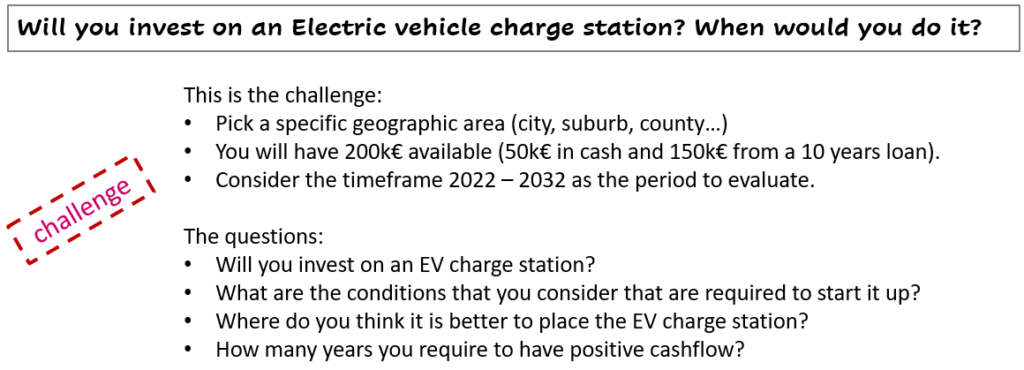
The idea is to build a consistent way to look at the future, find ways to detect potential changes that are going to happen, and try to detect if you can anticipate to them to take advantage. Think that is your own money.
On this post I will not focus on the type of solution you are going to implement, how you want to do it. There are thousand of possibilities.
The focus is to understand the landscape as best as possible, take notes of the assumptions and things we think that will happen, as a pre-mortem analysis taking 2027 and 2032 as key milestones.
The user and its needs
The people owning a car are continually going to a gas station to refuel. It’s an habit. Some people do it during work commute, some other when they are shopping, etc.
There are millions of car users and the type of car they pick and the main routes, habits and styles they have are infinite. They almost have something in common: they need to refuel, they have lack of time.
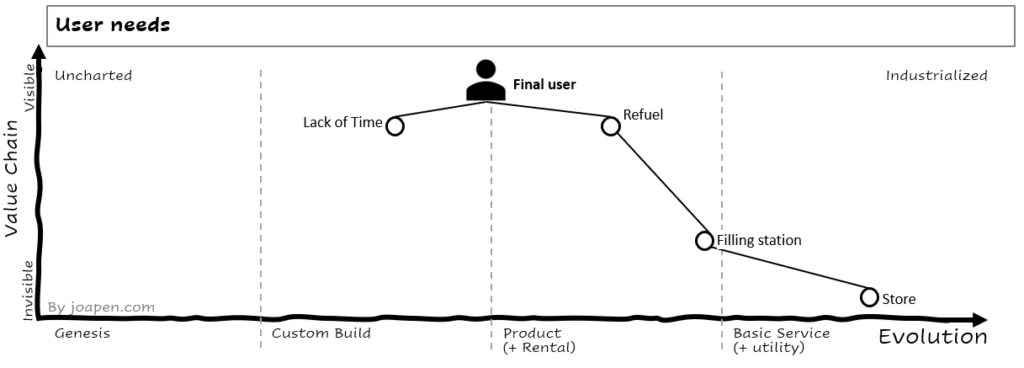
Right now, around the oil industry all is implemented: exploration, extraction, refining, distribution, laws (local and country)…
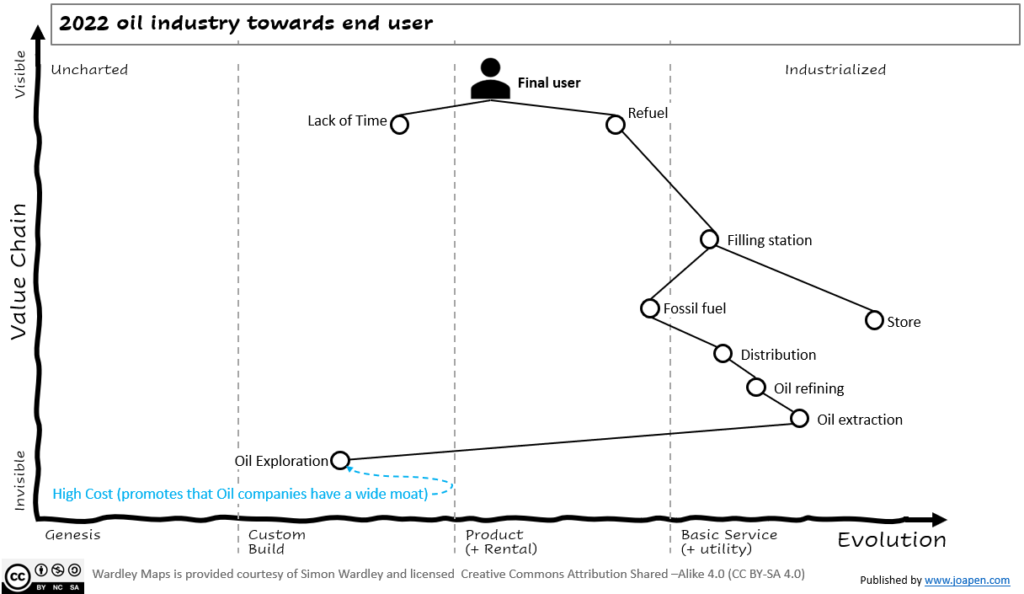
- Filling stations are right now a small convenience store with many different services available.
- Oil exploration continue being the element that requires more investment, making the oil companies to be one of the more restricted sector to start-up a company.
The emergence of the electric vehicle (EV)
The electric car has had a predecessor that is the hybrid car. This has been a huge catalyst for the growth of its use without hurting the user needs: be able to drive from starting point to destination. Despite this, I will not focus on them.
Let’s focus on the appearance of EV in the current landscape we have:
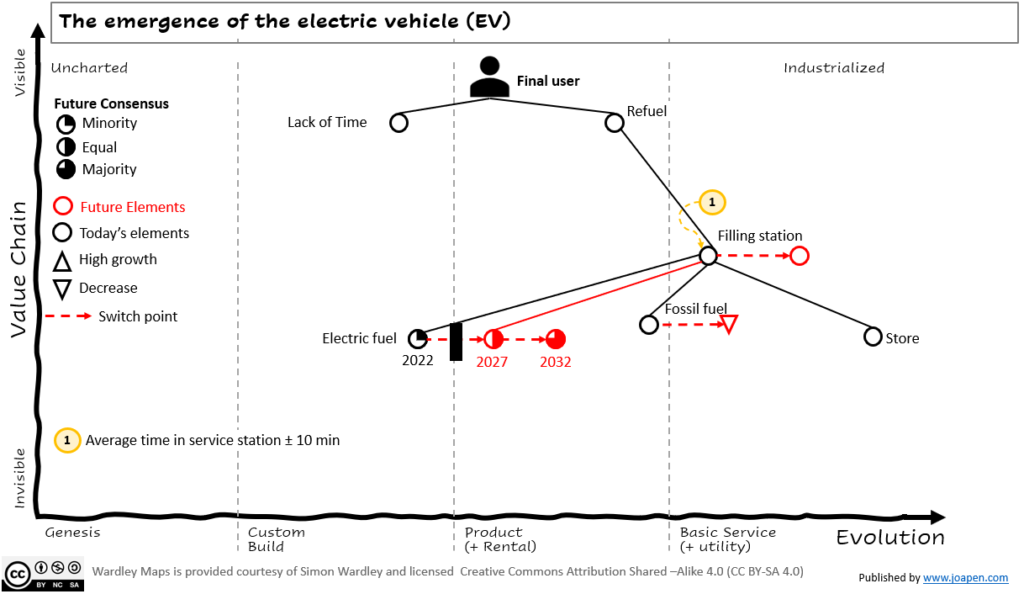
I assume that:
- Electric fuel will evolve from a minor percentage of consumption to a major one. Will be the predominant? I don’t know.
- Fossil fuels will evolve to a different stage where they will probably decrease their presence in the consumer car segment of automobiles.
Now let’s focus on the recharge time, I assume (premise) that it will improve and right now is something that depends on the charger and the availability of number of chargers vs EVs. Let’s assume the average charge time (fast and full charge) will evolve in this way:
- 2022 = fast 15 min / full 4 h
- 2027 = fast 10 min / full 1 h
- 2032 = fast 5 min / full 30 min
This makes that the current scenario of people charging their EV in a gas station (as we all know today) will be unacceptable in terms of time for the consumer. This makes that the main alternative some people are finding as appropriate is to charge the EV in a shopping center.

Shopping centers born as places to acquire many different type of products, and they have evolve to be an entertainment place with many different type of activities. The average time in a service station is around 10 minutes, while the average time in a shopping center is around 90 minutes.
What if the owners of these malls invest massively to provide recharge service? providing an answer to the need to save time during the week. Will the habits of people change to try to be more effective using their time?

The main question here is: how will evolve the habits of people?
- Are the people going to change their habits?
- Are shopping centers going to increase their offer on activities?
- Are electric companies going to partner with shopping centers so they can compete on this sector of the market?
- If in 5 years EVs average time to recharge will be so much efficient that we can continue refilling as today; will all this investment make sense?
- How are the filling stations going to counter-attack to attract more users?
Looking at the evolution from different perspectives
The evolution of EVs is not only the resolution of a technological challenge. It is required that other aspects of the society evolve too. I will simplify into these five perspectives:

Theses five different type of components above has to evolve, each one of them will evolve at different pace crossing many critical situations. All this will provoke the evolution of the whole EVs industry.
Note that filling stations technology are ready, but the number of filling stations are still growing a lot and they need to move accordingly with respect the real demand (demand / supply balance).
Note that “habits” is a component that you can perfectly consider as wrong into the list, but I’m adding it on purpose for adding to the map (when in reality it does not have “perfect” fit). On the map you will find it as “new habits”, as there are already habits when we are refueling the car today.
Climatic patterns
When we are looking at the future and try to understand it with the purpose of anticipating to it and gain some type of advantage, we unavoidably have to look to the climatic patterns.
Climatic pattern 1: Evolution consists of multiple waves of diffusion with many chasms
Let’s review some of the concepts around diffusion and evolution:
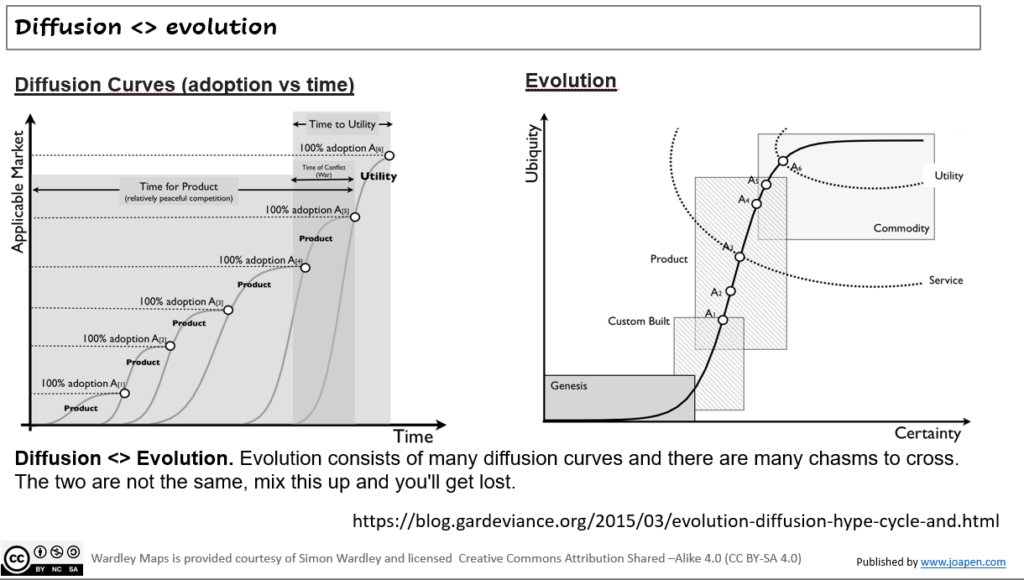
Diffusion <> evolution
In our scenario around EV recharge, we will see so many imbalances between supply and demand. I have highlighted these potential imbalances with the “capital flow” notation in light-blue.
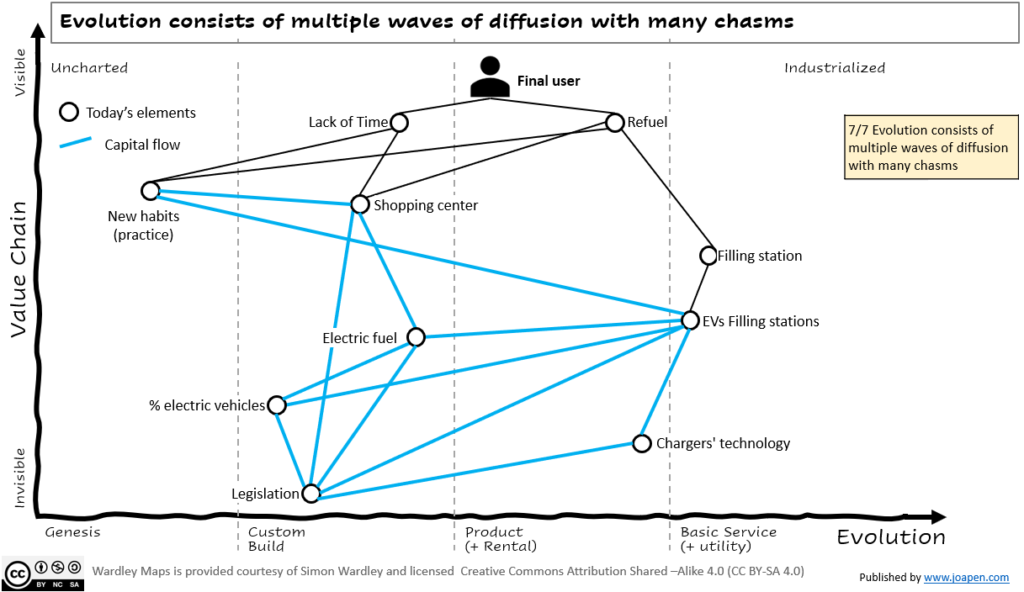
These imbalances will provoke some temporary chaotic situations, as for instance: big queue of cars waiting for being recharged:
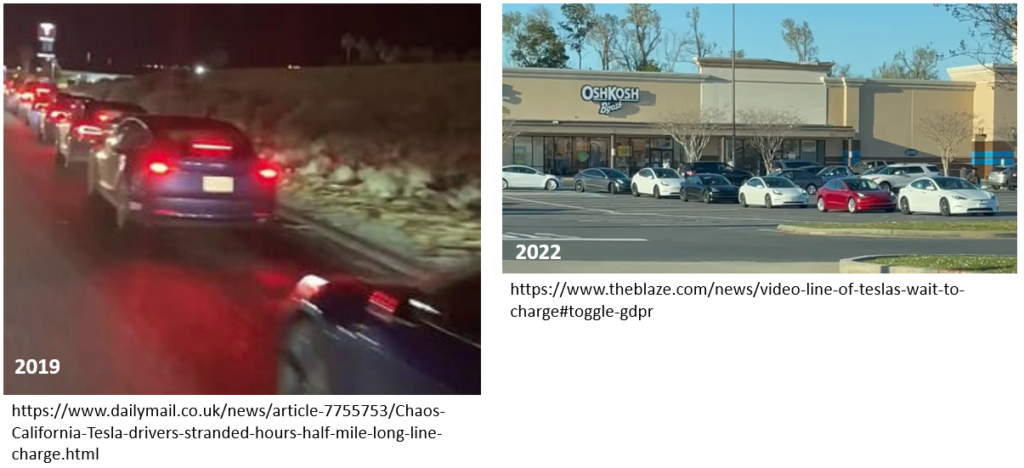
Just search “tesla wait in line charge” in your favorite search engine and find how this is evolving.
During summer 2022, California was facing a grid overload and some people are looking for alternatives:

Climatic pattern 2: Components can co-evolve
The five components I have added to the main map can evolve, but they can also co-evolve. The fifth element of the table “habits” will evolve from how we refuel today to a different type of habit. This change on how we do something is commonly seen with the co-evolution of practice (how we do something) due to the evolution of the activity (refuel).
In the map below, I simplify a scenario where a change in legislation can provoke an increase of users acquiring EVs, which will provoke an increase of lines in the EV’s filling stations which make the user think about how he could scape to the pain of being some hours of its precious time in a wait in line.
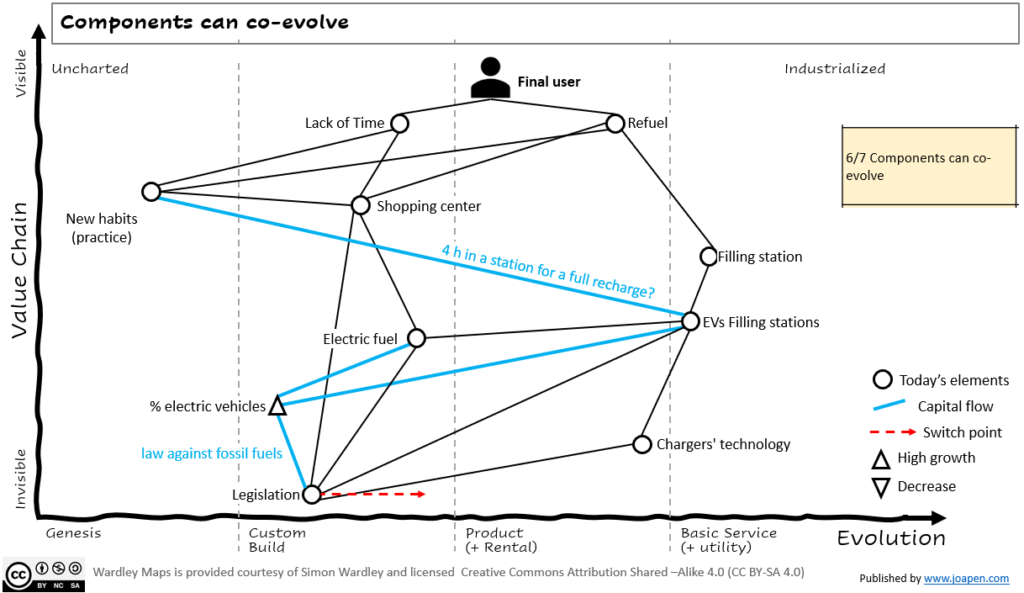
Climatic pattern 3: change is not always linear
The increase of sales in EVs is an important input for the need of new EVs filling stations required to attend that demand. It’s important to understand that this change does not happen in a linear way, but just the opposite. These increases are done in waves, that depends on different things: for instance, government incentives to acquire a EV with some type of tax reduction or subsidy.
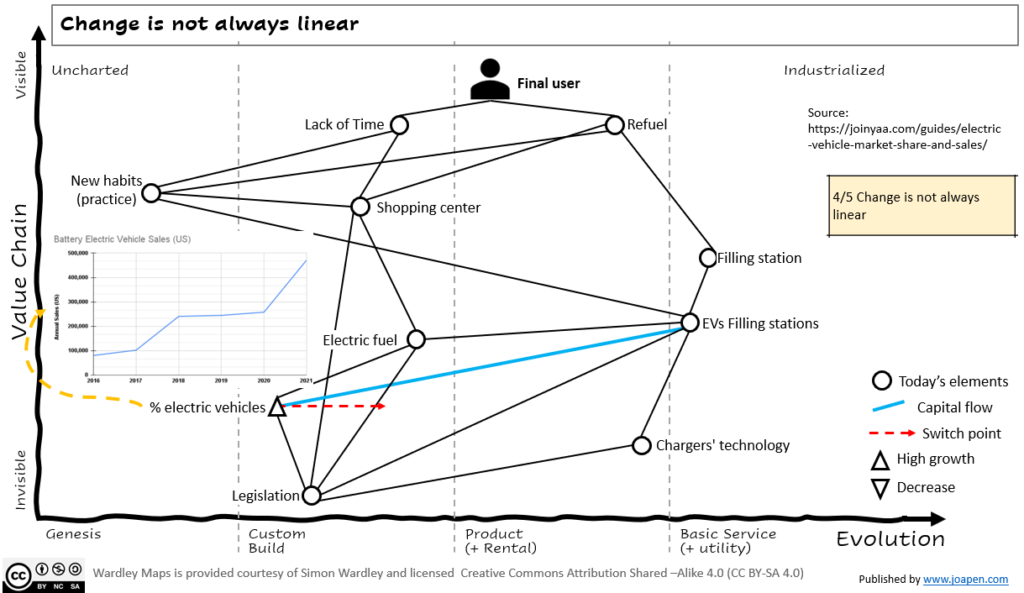
Climatic pattern 4: A competitors’ actions will change the game
Market effects such as the evolution of competition between supply and demand, the appearance of new competitors, the substitution of components and existing rivalries are aspects that must always be paid close attention to.
This chart of 5 forces of Porter helps to ask yourself relevant questions:
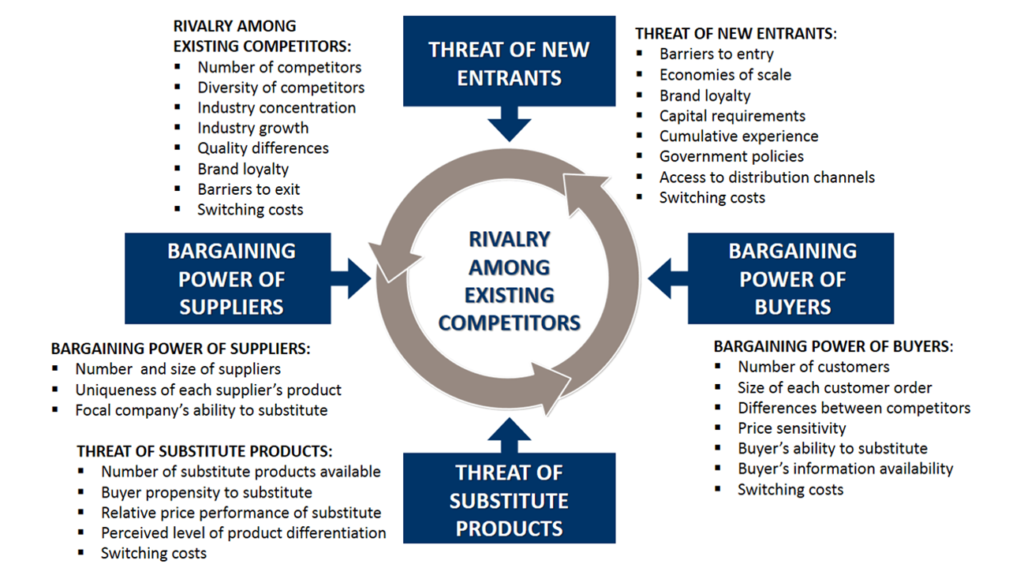
In our landscape we have mainly oil companies, but there are other major players we should pay attention to: electric companies and retail chains (major supermarket brands and REITs).
I have not idea about what each one of them are going to do, my bet is that:
- Electric companies: are going to invest aggressively on charge points and partnership to extend their distribution network.
- REITs: for sure are going to rent their space, and I think they are not going to go beyond that. Probably their investment will come in terms of solar plants in their facilities (parking lots and other buildings).
- Supermarkets: in the same way they have gas stations they are going to increase the offer using the parking lots they have, attracting customers to visit them more and stay more time there. I would pay attention to the volume of EVs chargers in the parking lots of the supermarkets. They are starting with few of them, but I’m sure they are going to increase the offer.

Climatic pattern 5: You cannot measure evolution over time or adoption
Measuring evolution over time is very difficult. The most reasonable thing is to detect the characteristics of a component throughout its evolution, from its genesis to basic service.
In our case, to look for data in our map would be something that could be useful. Qualitative and quantitative data that help us on anticipation. This data and changes can help us to detect the characteristics of a component through its evolution.
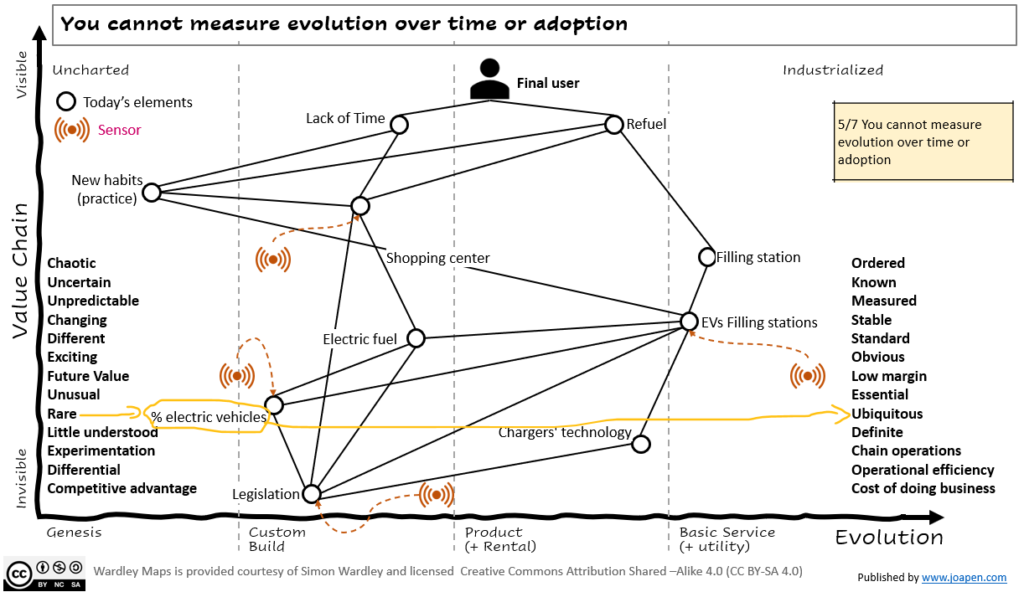
The premortem analysis
We can continue reviewing climatic patterns and specific data related to the context. Here as basic and wrong analysis I will try to make notes about how I think that the future of refueling will be in 2027 and 2032.
How will be refueling by 2027
- Majority of cars are still fed by fossil but EVs has a great presence on the cities and rural places.
- Many cities have a strong presence of EV chargers in different places: streets, shopping malls, office districts, and individual houses.
- As there are many EVs that are starting to be old, there is a second hand industry related to batteries. So many local businesses repair, recondition and improve low efficient batteries that can be reused.
- Laws related to EVs have matured and there are already restrictions to fossil cars into many cities.
- Electric companies have taken big part of the market thanks to alliances with
- Major supermarket brands have done their own investment and they continue to invest in solar energy to transition from oil to renewable energy.
- Oil companies have a strong presence in the market with all distribution capacity they have, specially in rural areas where shopping centers and electric companies are more reluctant to invest.
- The price of oil is higher than ever and oil companies are taking advantage of it as the transition to renewable energies is delayed.
- Major issues during summer happens in big cities: infrastructure is still not 100% ready to attend the demand of EVs.
- Electric companies increase their costs to be able to attend the huge demand.
- In countries where the demand has to be attended by law, electric companies have legal issues with the government.
- In major cities the amount of car services increase and the number of families without private car is relevant. The main reason: the cost of having a private car.
How will be refueling by 2032
- To be completed.
Appendix 1, Not considered in the analysis
- Charge at home = not considered as few amount of people can consider this as an option. In any case, the amount of people that will do a full charge at home will increase.
- Lower number of cars = there is a potential decrease of number of vehicles due to different factors = ride services (specially in cities), a percentage of young people is less attracted to drive, and other reasons.
- Specific country or geographic area: all this should be better to apply to a specific region or country. The main reason is consumers, government and auto-sellers behave different.
- Public parking: in the future is expected the streets will supply chargers for the EVs. In fact there are already places where you can find them.
- Hybrid cars: they are an important element in the transition to the EVs by many reasons: user acceptance, evolution of the technology, legislation, governments willing to invest, etc.
- Gameplays: I have focused on climatic patterns; I have not gone through gameplays the investor could use to take advantage.
- Other alternatives energies have not been included: as hydrogen or GLP.
Appendix 2, climatic patterns reviewed in this post
On this post I have reviewed some climatic patterns, but if you look at the table, for this proposed scenario you can review and find other patterns:
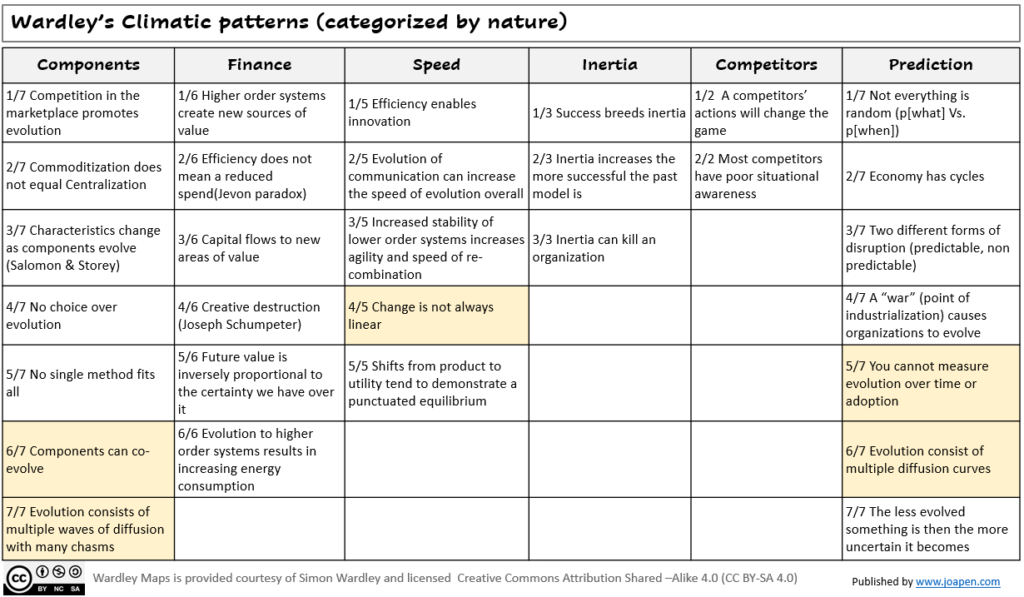
Closing
I hope you have found this interesting, constructive feedback is always welcome.
Draw your company strategy: A practical workbook for mapping business strategy
The book reviews the basic concepts of the maps: the user, user needs, climatic patterns, doctrines and gameplays. Then it describes how to create a strategy, add some examples in different contexts, and finally review other frameworks that provide other perspectives on the strategy.
The book format tries to be visual and gives spaces to the reader so you can draw and take your notes. In many of the concepts I have memorized examples that reminds me how the concept works. I use them during the explanation of the concepts, but my proposal is the reader thinks about examples related to your circle of competence and experience.

Of course, there is a good chance that everyone will switch to electricity, but it is still an open question with long distance trips, especially in areas where there are no fast chargers.
I agree James, this and others are key questions to be resolved. From the point of view of long distance trips, it’s a technological hurdle and the amount of EVs charge is another perspective to be considered.
As they both evolve together, this co-evolution will promote the adoption of EVs by end users.
Another question would be: is there any unknown bottleneck that potentially can slow down the adoption of EVs? For instance minerals scarcity…
thanks for your comment